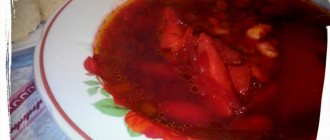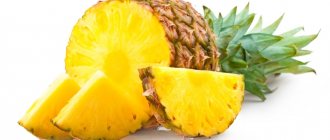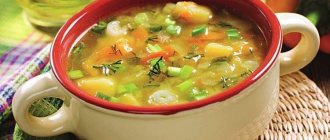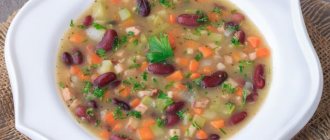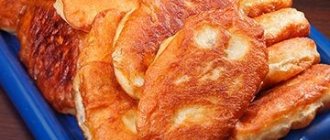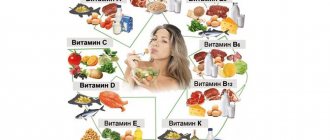Since childhood, we hear how important it is to eat first things first. Shchi, borscht, and solyanka have become an integral part of the diet for many. Soup is a source of nutrients. It consists mainly of liquid, so the energy value of soups is relatively low. In this case, saturation occurs quickly. But which of the most popular dishes are the healthiest?
Fry, boil or bake: which cooking method is healthier?
Are fried foods really that bad?
Solyanka mixed meat in other portions:
103
1.03
| Qty | A portion | Calories | In the counter |
| 100 g | 103 | ||
| 1 g | 1.03 | ||
| 175 | 1 ladle (140 ml) = 170g | 175 | |
| 350 | 1 plate = 340g | 350 | |
| 21 | 1 tablespoon = 20g | 21 |
Unusual solyanka with amazing taste
Traditionally, pickled cucumbers are an obligatory component in solyanka. However, not everyone likes its taste. Replace cucumbers with pickled mushrooms, and the hodgepodge will sparkle with bright flavor notes. And so that the dish does not bring us a lot of calories, we will cook it using chicken meat.
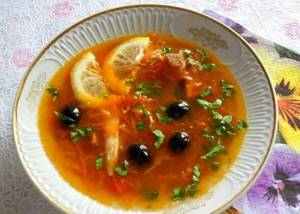
Ingredients:
- chicken leg - one piece;
- onion - two heads;
- carrot - one root vegetable;
- tomatoes - five pieces;
- pickled mushrooms – 0.1 kg;
- ketchup - two tables. spoons;
- olives - ten pieces;
- half a lemon;
- parsley;
- purified vegetable oil - two tablespoons. spoons;
- salt;
- olive brine.
Preparation:
- We will prepare all the products we need. We clean and wash the onions and carrots. We also rinse the tomatoes and chicken legs under running water.
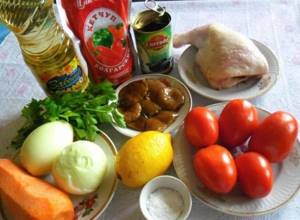
- Place the leg into the pan. Fill it with purified water.
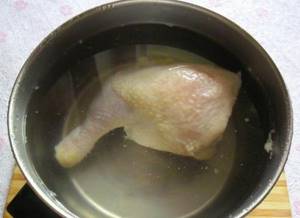
- Let's wait for the liquid to boil. Be sure to remove any foam that appears using a slotted spoon.
- Then add salt to the water and add washed sprigs of dill and parsley to the ham.
- In the meantime, let's prepare the vegetables we need. You need to remove the skin from the tomatoes. To do this, pour boiling water over them and leave for five minutes.

- Then hold the tomatoes under running cold water. Then we make cross cuts on the top of the fruit. Now let's free them from the skin with ease.

- Chop the onion into small cubes.
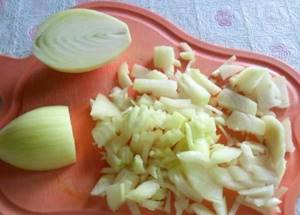
- We chop the carrots using a special vegetable peeler. If you don’t have one, grate the vegetable using a regular grater (but not finely).
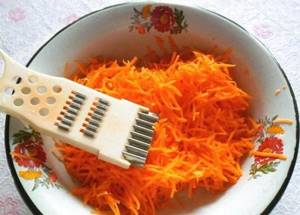
- By this time our leg should have been cooked.
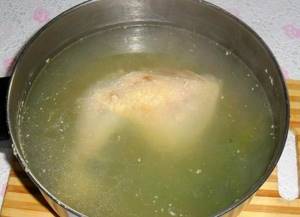
- Let's take it out. Strain the broth so that it is clear and beautiful. To do this, place a piece of gauze on a sieve or colander.
- When the meat has cooled a little, separate the pulp from the bones and tear it into fibers.

- In a frying pan, heat the refined vegetable oil. Place the onion in it and fry for a couple of minutes.

- Add carrots to the onion. While stirring, sauté for two minutes.
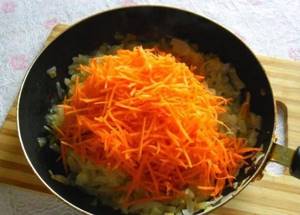
- Cut the mushrooms into small pieces.
- Place them in a frying pan with the vegetables.
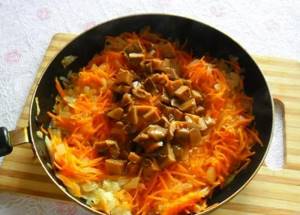
- Cut the tomatoes into small cubes.

- Add tomato pieces to the pan.
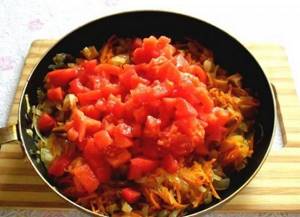
- For a couple of minutes, stirring, fry the mushrooms with assorted vegetables. Then add ketchup.
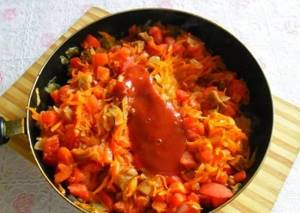
- Stir well and simmer everything until the tomatoes become soft.
- Bring the broth to a boil.
- Place vegetables and mushrooms in it.
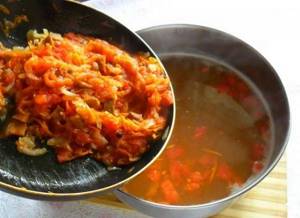
- Cook the hodgepodge on a low burner for fifteen minutes. The main thing is that the vegetables do not overcook and become mushy.
- Then add one or two tablespoons to the soup. spoons of olive marinade.
- Add meat pulp.
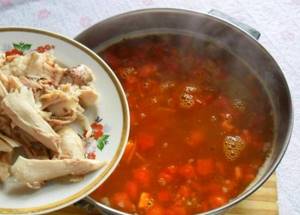
- We wait for the hodgepodge to boil and boil it for just a minute.
- Turn off the burner. Our hodgepodge is ready.

- This treat must be served correctly: pour the hodgepodge into portioned plates and add 2-3 olives and two lemon slices. The final touch is chopped greens.
Composition of nutrients, BJU
Solyanka meat
| For quantity: 100 grams | ||
| Calories — 103 | Calories in fat - 70 | |
| BJU | ||
| Total fat content | 7.73g | |
| Saturated | 2.74g | |
| Polyunsaturated | 0.91g | |
| Monounsaturated | 3.51g | |
| Cholesterol | 24mg | |
| Total carbohydrate content | 1.69g | |
| Dietary fiber | 0.43g | |
| Sugar | 0.61g | |
| Squirrels | 6.76g | |
| Vitamins and microelements | ||
| A - 30.09 µg | C - 365.96 mg | |
| B-6 – 0.15 mg | B-12 - 0.61mcg | |
| D - 0.17 µg | E - 0.32 mg | |
| Calcium 14 µg | Iron 0.77 mg | |
| Magnesium 9.73 mg | Zinc 1.3mg | |
| Potassium 161 mg | Sodium 264 mg | |
Distribution of calories for BJU:Carbohydrates (7%) Fats (67%) Proteins (26%) | ||
Solyanka recipe. Calorie, chemical composition and nutritional value.
Nutritional value and chemical composition of Solyanka.
The table shows the nutritional content (calories, proteins, fats, carbohydrates, vitamins and minerals) per 100 grams of edible portion.
| Nutrient | Quantity | Norm** | % of the norm in 100 g | % of the norm in 100 kcal | 100% normal |
| Calorie content | 63.9 kcal | 1684 kcal | 3.8% | 5.9% | 2635 g |
| Squirrels | 3.3 g | 76 g | 4.3% | 6.7% | 2303 g |
| Fats | 3.7 g | 56 g | 6.6% | 10.3% | 1514 g |
| Carbohydrates | 3.2 g | 219 g | 1.5% | 2.3% | 6844 g |
| Organic acids | 0.1 g | ~ | |||
| Alimentary fiber | 0.3 g | 20 g | 1.5% | 2.3% | 6667 g |
| Water | 88.3 g | 2273 g | 3.9% | 6.1% | 2574 g |
| Ash | 0.782 g | ~ | |||
| Vitamins | |||||
| Vitamin A, RE | 29.5 mcg | 900 mcg | 3.3% | 5.2% | 3051 g |
| beta carotene | 0.179 mg | 5 mg | 3.6% | 5.6% | 2793 g |
| Vitamin B1, thiamine | 0.015 mg | 1.5 mg | 1% | 1.6% | 10000 g |
| Vitamin B2, riboflavin | 0.011 mg | 1.8 mg | 0.6% | 0.9% | 16364 g |
| Vitamin B4, choline | 1.88 mg | 500 mg | 0.4% | 0.6% | 26596 g |
| Vitamin B5, pantothenic | 0.045 mg | 5 mg | 0.9% | 1.4% | 11111 g |
| Vitamin B6, pyridoxine | 0.039 mg | 2 mg | 2% | 3.1% | 5128 g |
| Vitamin B9, folates | 1.123 mcg | 400 mcg | 0.3% | 0.5% | 35619 g |
| Vitamin C, ascorbic acid | 1.9 mg | 90 mg | 2.1% | 3.3% | 4737 g |
| Vitamin E, alpha tocopherol, TE | 0.31 mg | 15 mg | 2.1% | 3.3% | 4839 g |
| Vitamin H, biotin | 0.092 mcg | 50 mcg | 0.2% | 0.3% | 54348 g |
| Vitamin K, phylloquinone | 1.2 mcg | 120 mcg | 1% | 1.6% | 10000 g |
| Vitamin RR, NE | 0.2305 mg | 20 mg | 1.2% | 1.9% | 8677 g |
| Niacin | 0.163 mg | ~ | |||
| Macronutrients | |||||
| Potassium, K | 84.94 mg | 2500 mg | 3.4% | 5.3% | 2943 g |
| Calcium, Ca | 5.97 mg | 1000 mg | 0.6% | 0.9% | 16750 g |
| Silicon, Si | 3.641 mg | 30 mg | 12.1% | 18.9% | 824 g |
| Magnesium, Mg | 4.65 mg | 400 mg | 1.2% | 1.9% | 8602 g |
| Sodium, Na | 235.22 mg | 1300 mg | 18.1% | 28.3% | 553 g |
| Sera, S | 6.27 mg | 1000 mg | 0.6% | 0.9% | 15949 g |
| Phosphorus, P | 10 mg | 800 mg | 1.3% | 2% | 8000 g |
| Chlorine, Cl | 301.29 mg | 2300 mg | 13.1% | 20.5% | 763 g |
| Microelements | |||||
| Aluminium, Al | 65.5 mcg | ~ | |||
| Bor, B | 12.3 mcg | ~ | |||
| Vanadium, V | 11.01 mcg | ~ | |||
| Iron, Fe | 0.191 mg | 18 mg | 1.1% | 1.7% | 9424 g |
| Yod, I | 0.58 mcg | 150 mcg | 0.4% | 0.6% | 25862 g |
| Cobalt, Co | 1.038 mcg | 10 mcg | 10.4% | 16.3% | 963 g |
| Lithium, Li | 5.159 mcg | ~ | |||
| Manganese, Mn | 0.0243 mg | 2 mg | 1.2% | 1.9% | 8230 g |
| Copper, Cu | 25.04 mcg | 1000 mcg | 2.5% | 3.9% | 3994 g |
| Molybdenum, Mo | 1.728 mcg | 70 mcg | 2.5% | 3.9% | 4051 g |
| Nickel, Ni | 0.451 mcg | ~ | |||
| Rubidium, Rb | 38.7 mcg | ~ | |||
| Selenium, Se | 0.11 mcg | 55 mcg | 0.2% | 0.3% | 50000 g |
| Strontium, Sr | 1.08 mcg | ~ | |||
| Fluorine, F | 3.17 mcg | 4000 mcg | 0.1% | 0.2% | 126183 g |
| Chromium, Cr | 0.79 mcg | 50 mcg | 1.6% | 2.5% | 6329 g |
| Zinc, Zn | 0.0768 mg | 12 mg | 0.6% | 0.9% | 15625 g |
| Zirconium, Zr | 0.2 mcg | ~ | |||
| Digestible carbohydrates | |||||
| Starch and dextrins | 1.583 g | ~ | |||
| Mono- and disaccharides (sugars) | 0.6 g | max 100 g | |||
| Glucose (dextrose) | 0.118 g | ~ | |||
| Sucrose | 0.219 g | ~ | |||
| Fructose | 0.044 g | ~ | |||
| Essential amino acids | 0.088 g | ~ | |||
| Arginine* | 0.014 g | ~ | |||
| Valin | 0.014 g | ~ | |||
| Histidine* | 0.004 g | ~ | |||
| Isoleucine | 0.011 g | ~ | |||
| Leucine | 0.015 g | ~ | |||
| Lysine | 0.016 g | ~ | |||
| Methionine | 0.003 g | ~ | |||
| Methionine + Cysteine | 0.006 g | ~ | |||
| Threonine | 0.012 g | ~ | |||
| Tryptophan | 0.004 g | ~ | |||
| Phenylalanine | 0.012 g | ~ | |||
| Phenylalanine+Tyrosine | 0.023 g | ~ | |||
| Nonessential amino acids | 0.147 g | ~ | |||
| Alanin | 0.012 g | ~ | |||
| Aspartic acid | 0.03 g | ~ | |||
| Glycine | 0.012 g | ~ | |||
| Glutamic acid | 0.035 g | ~ | |||
| Proline | 0.011 g | ~ | |||
| Serin | 0.015 g | ~ | |||
| Tyrosine | 0.011 g | ~ | |||
| Cysteine | 0.003 g | ~ | |||
| Sterols (sterols) | |||||
| beta sitosterol | 1.218 mg | ~ | |||
| Saturated fatty acids | |||||
| Saturated fatty acids | 0.1 g | max 18.7 g | |||
| 16:0 Palmitinaya | 0.046 g | ~ | |||
| 18:0 Stearic | 0.027 g | ~ | |||
| 20:0 Arakhinovaya | 0.002 g | ~ | |||
| 22:0 Begenovaya | 0.004 g | ~ | |||
| Monounsaturated fatty acids | 0.163 g | min 16.8 g | 1% | 1.6% | |
| 16:1 Palmitoleic | 0.001 g | ~ | |||
| 18:1 Oleic (omega-9) | 0.162 g | ~ | |||
| Polyunsaturated fatty acids | 0.405 g | from 11.2 to 20.6 g | 3.6% | 5.6% | |
| 18:2 Linolevaya | 0.373 g | ~ | |||
| 18:3 Linolenic | 0.009 g | ~ | |||
| Omega-6 fatty acids | 0.4 g | from 4.7 to 16.8 g | 8.5% | 13.3% |
The energy value of Solyanka is 63.9 kcal.
Primary Source: Created in the application by the user. Read more.
** This table shows the average levels of vitamins and minerals for an adult. If you want to know the norms taking into account your gender, age and other factors, then use the “My Healthy Diet” application.
Technical characteristics of the multicooker

- Type – multicooker
- Case material: plastic
- Volume - 4 l.
- Power - 980 W.
- Bowl coating: Teflon
- Control – electronic
- Manual adjustment – cooking time
- Keep warm - yes
- Delayed start – yes
- Automatic programs - baking, porridge, cereals, stewing, steaming.
And since I am going to cook food using my household appliance, and not repair it myself, this knowledge is quite enough for me.
Automatic programs allow you to prepare a huge variety of dishes to choose from: fluffy rice and buckwheat, aromatic stewed soups, delicious milk porridges, fluffy pastries.
One of the main differences between my multicooker and similar models is its durable bowl with thick walls.
Cabbage solyanka with meat is a simple option. I started mastering the slow cooker with this recipe. An undeniable advantage of using a multicooker is the speed of cooking and the simplicity of the process. There are other benefits, too, such as the ability to create richly flavored food that is more flavorful than cooked in a regular pan.
Solyanka is a tasty and satisfying dish, quite popular in the world, and in some countries it is even traditional and national. The big advantage of solyanka is that it can be prepared from different ingredients.
Stewed cabbage with mushrooms - PP recipe
Mushroom lovers can always prepare such a simple dish.
- 600 grams of cabbage. By the way, you can use not only white cabbage, but even Peking cabbage.
- 300 grams of champignons.
- onion + carrots. Let's cut it.
- half a can of tomatoes in their own juice.
- Salt and spices to taste.
We won't fry anything in this recipe. Place all the ingredients in a frying pan, add salt and pepper, cover with a lid and cook for about 40 minutes.
PP stewed cabbage with chicken
A very simple and quick recipe in a frying pan, which will be an excellent dinner or lunch. You will need:
- 500 grams of chicken fillet. We cut it into pieces.
- 1 carrot. Grate it.
- 1 onion. Finely chop.
- 3 tomatoes. Grate.
- 1 bell pepper. Cut into strips.
- 600 grams of white cabbage.
- 1 p. l. any vegetable oil.
- Salt and spices to taste.
Fry the chicken meat in one spoon of oil, then add vegetables to it. Cook for another 5 minutes and add tomatoes and peppers. Simmer for a couple more minutes and add the cabbage at the very end. Salt and pepper. Cook for about 25 minutes.
